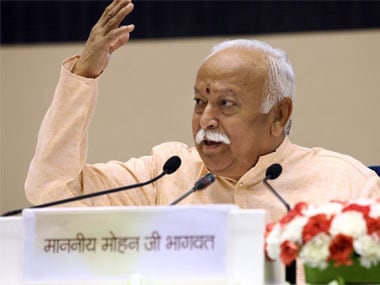Once upon a time, the male patriarch’s perception of an ideal wife was one who stayed “barefoot and pregnant in the kitchen”. Today, at a time when millennials are beginning to rethink the institution of marriage itself and redefining the idea of partnership, RSS chief Mohan Bhagwat made a rather bizarre and archaic statement about divorce. [caption id=“attachment_8048521” align=“alignleft” width=“380”]  File image of RSS chief Mohan Bhagwat. PTI[/caption] While addressing a meeting of RSS workers and their families in Ahmedabad, he said that divorce cases, “are more in educated and affluent families because with education and affluence, comes arrogance, as a result of which families fall apart.” The irony is that while the first part of the statement may be somewhat true, it is ridiculous to suggest that the “arrogance” of the rich and the educated is the main cause of divorce.
The truth lies elsewhere: It is the educated and affluent who have the means and the social support to go through with a divorce.
Those who are less privileged and need to get out of bad marriages stay trapped in them for several other obvious reasons. Arrogance has nothing to do with it. What Bhagwat was really talking about was “matru shakti”, not divorce. Women, he said, needed to stay in their families and be the cohesive force; they are the apparent glue that holds together families, and through them, societies. They need to be “enlightened” and not “confined to their homes”, but they should not break out of the family and become independent. Archaic though he sounds, Bhagwat is not alone in his perception. In the sanskari bubble in which he lives, financially independent and empowered women are suspect. I once heard a renowned Sanskrit scholar publicly warning husbands against allowing their educated and employed wives to have separate bank accounts. Giving them too much freedom would disrupt families, he warned. Despite the rise from 0.50 per 1000 in 1988 to 3.0 in 2015, India still has one of the lowest divorce rates in the world. But, as legal experts and counsellors dealing with divorce cases point out, it is not because levels of marital discord or domestic violence are low in the country, or because “traditions” and “family values” hold sway. It is because most women do not have access to legal aid. The marginal increase in divorce rates can be attributed to financial independence and a stronger sense of self-worth, which have given many educated women the courage to take a decision which can have many social and monetary repercussions. Although both men and women suffer when there is a painful divorce, more often than not it is the women who bear the brunt of such decisions. Infidelity, alcoholism, sexual incompatibility, dowry harassment are just some of the triggers which lead to the break up of marriages. An NRCB survey of women in violent marriages in India shows that women who belong to scheduled castes between the ages of 15 and 24 with no formal schooling, whose husbands also have no formal schooling and who live in nuclear families, are the most abused, both physically and psychologically. Yet these are the women who do not have access to the means required to get a divorce. The husbands of many of these women are also alcoholics who don’t support the family. A lack of resources and faith in divorce as a concept deters such women from leaving their husbands, and even when they do, they may choose to stay single or move on to other partners. In either case, divorce does not come into the picture. In countries like the US, divorce rates are now beginning to plummet, not because couples are now willing to stay in dysfunctional marriages, but because they don’t want to get married at all. Millennials in particular find marriage messy and would rather just live in together. Millennials in India are also getting there. Like their counterparts abroad, they don’t want to get married. But importantly, unlike in the West, in India it is only the “educated and affluent” millennials who have the social and financial support which enables them to reject marriage or walk out of it. For the majority of the young, marriage is still mandatory. Underage marriages are still the norm, especially in less privileged households. Additionally, women still bear several children before they reach the age of 20, and their circumstances force them to work and support their families. According to the last National Family Health Survey, every third woman aged above 15 has faced domestic violence of various forms across our country. Most times the perpetrators of this violence have been the husbands. Thirty-one percent of married women have experienced physical, sexual, or emotional violence at the hands of their spouses. The survey reported that among married women who have experienced physical violence since the age of 15, 83 percent reported their present husbands as perpetrators of the violence. Every third married woman who has experienced spousal violence spoke of violent assaults resulting in eye injuries, sprains, dislocations, burns, broken bones and broken teeth. Yet, only 14 percent of the women who experienced this violence sought help to stop it. But the silver lining, according to the survey, is education — not income or even age. The report found that women who went to school as children were more likely to report physical violence. Although schooling does not automatically reduce spousal violence, it gives the women an important tool to fight back with.


)

)
)
)
)
)
)
)
)



